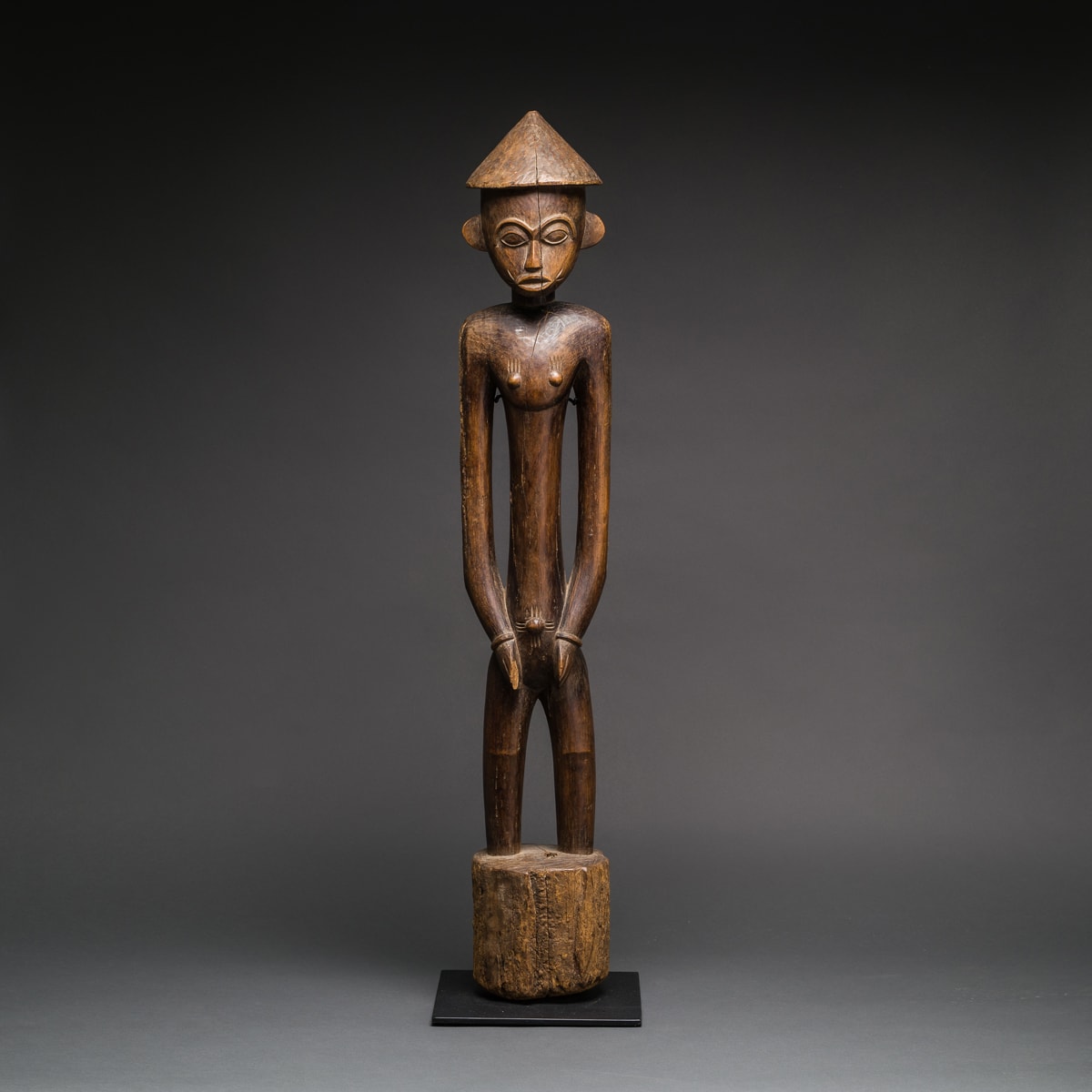Male Senufo Wooden Pombiele Rhythm Pounder, 20th Century CE
Wood
85.7 x 14.6 cm
33 3/4 x 5 3/4 in
33 3/4 x 5 3/4 in
PF.3053 (LSO)
Further images
This unusual piece is a pombilele or “rhythm pounder” sculpture, made by the Senufo people of the Ivory Coast and Mali. It is a highly unorthodox design, with familiar elements...
This unusual piece is a pombilele or “rhythm pounder” sculpture, made by the Senufo people of the Ivory Coast and Mali. It is a highly unorthodox design, with familiar elements including the columnar integral base (without feet), short legs, an elongated thorax and long arms with the hands resting on the upper thighs. Gender is uncertain, but it is likely to be male – itself an unusual finding. The head is also unusual, with small, retrousse features, an open mouth, eyes situated close together and the most extraordinary conical hat that is as wide as the figure’s prominent, plate-like ears. Detail is otherwise restricted to nipples, umbilicus and a bracelet on each wrist. Patination is uneven, indicating extensive usage and considerable age.
The Senufo group, based in the Ivory Coast and Mali area, has a long history of using highly decorated objects in many aspects of everyday life. However, their extremely high level of skill in woodcarving is nowhere better seen than in the realm of their magical-religious art. At the heart of Senufo society is a patriarchal groups of elders known as the Poro society, which is responsible for many religious and more urbane functions to do with the running of the tribal group. Their ceremonial events are often associated with dancing, music and the use of Pombilele sculptures.
“Pombilele” literally translates as “those who give birth”, and traditionally constitute a pair of figures (one male, one female) who represent primordial humanity and the ancestry of all humankind. Most examples, however, are of single, female figures, making this example somewhat unusual. The appearance of these figures is relatively homogenous, being tall, slim and somewhat angular. However, the personal characteristics of each sculpture were often based upon a dream or vision by a Poro elder. There is also some social and geographic variability. The figures were used as pounding devices (holding each arm) to keep the rhythm for dancing, or were stood for purposes of contemplation in the middle of the Poro society’s sacred enclosures. They are also used for the interment of prominent Poro members; they are carried to the graveside with the dead body, then used to tamp down the earth on top of the grave, to ensure that the spirit of the dead is directed to the afterlife rather than returning to haunt the living.
This is a striking and attractive piece of African art.
The Senufo group, based in the Ivory Coast and Mali area, has a long history of using highly decorated objects in many aspects of everyday life. However, their extremely high level of skill in woodcarving is nowhere better seen than in the realm of their magical-religious art. At the heart of Senufo society is a patriarchal groups of elders known as the Poro society, which is responsible for many religious and more urbane functions to do with the running of the tribal group. Their ceremonial events are often associated with dancing, music and the use of Pombilele sculptures.
“Pombilele” literally translates as “those who give birth”, and traditionally constitute a pair of figures (one male, one female) who represent primordial humanity and the ancestry of all humankind. Most examples, however, are of single, female figures, making this example somewhat unusual. The appearance of these figures is relatively homogenous, being tall, slim and somewhat angular. However, the personal characteristics of each sculpture were often based upon a dream or vision by a Poro elder. There is also some social and geographic variability. The figures were used as pounding devices (holding each arm) to keep the rhythm for dancing, or were stood for purposes of contemplation in the middle of the Poro society’s sacred enclosures. They are also used for the interment of prominent Poro members; they are carried to the graveside with the dead body, then used to tamp down the earth on top of the grave, to ensure that the spirit of the dead is directed to the afterlife rather than returning to haunt the living.
This is a striking and attractive piece of African art.





